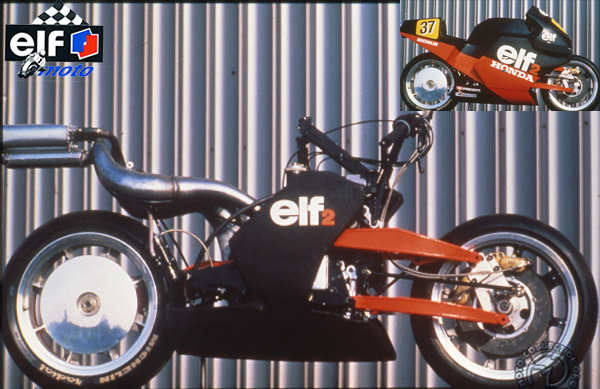
Photo ou archives : F-M. Dumas
302
Elf
Elf-2 500 GP
Advanced Design
When in the late Seventies the French oil company Elf decided to produce a racing bike, they commissioned André de Cortanze, an engineer experienced in race car design, but new to cycles.
Unveiled at the beginning of 1978, the Elf-X displayed remarkably advanced thinking, with parallelogram front suspension, carbon fiber brakes, a fuel tank beneath the power unit, and the engine doubling as the frame. Powered by a Yamaha TZ 750, this first effort was quickly redesigned, gaining single-arm rear suspension and a 1000cc Honda power unit. Now known as the Elf-E, it was intended for endurance races like the Bol d'Or. But it showed such promise that Elf decided to develop a real Grand Prix racer.
More Innovations
Powered by a three-cylinder Honda NS 500, the Elf-2 went further along the trail of innovation, with bell-crank steering and suspension units housed under the engine. But it proved tricky to handle, so the 2A and 2B evolution versions had more conventional steering and suspension. The 1986 Elf-3 had MacPherson Strut front suspension, intended to solve the problems experienced with the parallelogram suspension. It finished ninth in the world championship. The 1987 Elf-4, with four-cylinder Honda NSR power, and the ultimate version, the Elf-5 of 1988, failed to make the grade. Elf decided to withdraw from racing.
SPECIFICATIONS
• Engine: 500cc Honda water-cooled two-stroke V-twin
• Power output: 130 hp
• Valves: 4 per cylinder
• Fuel system: carburetors
• Transmission: 6-speed gearbox
• Suspension: (front) parallelogram; (rear) single arm, springing units coupled under the engine
• Brakes: (front) carbon fiber disc; (rear) carbon fiber disc
• Wheels: cast alloy
• Weight: 265 lb
• Maximum speed: 186 mph
No frame, coupled suspension, bellcrank steering - the 1984 Elf-2 was without question the most revolutionary of all the Elf machines.